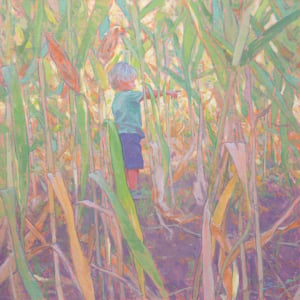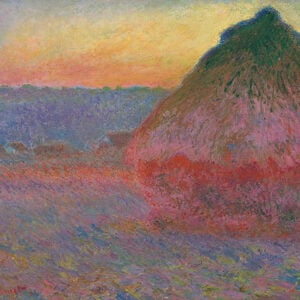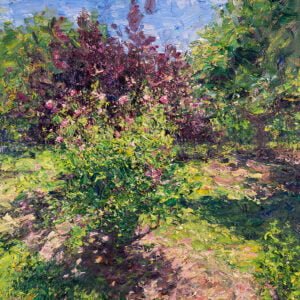Mary Cassatt was an American painter and printmaker who became one of the most prominent members of the Impressionist group. She is best known for her artworks which depict the daily lives of women and the relationship between mothers and children. Cassatt was one of the very few women who managed to achieve critical and commercial success at a time when female artists were mostly ignored. In this post, I’ll cover:
- Key Facts
- Style and Technique Breakdown
- A Closer Look at Some of Cassatt’s Paintings
- Self-Portrait
- Signature
- Mary Cassatt Quotes
- Want to Learn More?
- Thanks for Reading!

Key Facts
- Mary Cassatt was born into a wealthy family. Her mother came from a banking family and her father was a stockbroker. Though she was born in the United States, the Cassatt’s lived in France and Germany between 1851 and 1855 with Mary spending part of her childhood in Europe.
- Cassatt studied art at the Pennsylvania Academy of Fine Arts. She did not finish her studies, as she thought the teachers and male students were patronizing. Instead, Cassatt continued her art education in France.
- In 1968, one of Mary’s artworks “The Mandolin Player” was exhibited at the famous Salon in Paris alongside the work of fellow American Elizabeth Jane Gardner. This made Mary one of the first two American females to display their artwork in the exhibit.

- In 1877, Cassatt met fellow Impressionist Edgar Degas, who invited her to exhibit with the Impressionists. This led to Cassatt being the only American artist who exhibited with the Impressionists in Paris.
- Degas helped Cassatt with the use of pastels and engraving. They remained friends for decades. Below is a portrait of Cassatt by Degas. What I find most interesting about this painting is how Degas used thick, light orange paint in the background to push Cassatt forward in perspective. The thick paint and chaotic brushwork in the background also contrast against the delicate brushwork used for Cassatt’s face.

- Cassatt was not fond of Degas’ portrait of her (above). She wrote to her art dealer, Paul Durand-Ruel in 1912 or 1913, “It has artistic qualities but it is painful and depicts me as such a repugnant person, I don’t want anyone to know that I posed for it.”
- Japanese art had a major influence on Cassatt’s work. Japanese prints gained popularity in Paris after the 1878 Exposition Universale which featured works by Japanese masters. Prints by Kitagawa Utamaro particularly appealed to Cassatt as both artists shared a profound interest in the daily life of women.

Style and Technique Breakdown
Cassatt had a very distinctive style, with soft, pastel colors and loose brushwork. Just like Degas, Mary shared a passion for drawing and painted her subjects in solid lines. This set her artworks apart from the works of many other Impressionists, who mainly painted with broken lines and dissolved forms.
The painting below is a stunning example of this. Cassatt loosely painted soft, pastel colors within the defined edges of the drawing.

Cassatt was extremely good at painting within tight value ranges whilst varying the hue of her colors. This allowed her to paint such colorful works like the one below, without compromising the overall structure and construction of the painting. Also, notice how she mostly uses weak versions of colors (not many strong, saturated colors). The strongest color in the painting below appears to be the red rose in her hands.

The still life painting below is more typical work of Impressionism, with broken color and less focus on the drawing. Notice how Cassatt used common colors all throughout the painting; purples for the flowers and also the background; greens for the leaves and also the floor; pinks for the background and also the foreground. The end result is a very harmonious arrangement of colors.

A Closer Look at Some of Cassatt’s Paintings
This is one of Cassatt’s most recognizable works. It features a young girl who is thought to be the daughter of close friend Edgar Degas. She is reclining in the seat, dwarfed by the adult furniture. Saturated blues and greens dominate the weaker grays and soft pastel colors used in the rest of the painting. The negative space between the chairs also creates some interesting shapes which form an important element of the composition.

The Child’s Bath combines the artist’s interest in domestic life and Japanese art. It features an intimate moment between a mother and child from a slightly elevated vantage point which is typical of Japanese woodblock prints. The influence of Japanese art is also visible in the intricate wallpaper and tile patterns. It is a very gentle painting, which uses soft colors and delicate brushwork to suggest the close bond between the mother and child.

With this painting, Cassatt stays within the theme of mother and child, but ventures away from the typical interior view of a domestic life. The mother and child are on a boat, rowed by an unknown man. As with most of her paintings, soft, pastel colors are utilized for the mother and child, which contrasts against the dark and imposing colors used for the man. It is an interesting composition, with part of the boat cropped out and only a small area left for the sky in the background.

Self-Portrait
Here is a self-portrait by Mary Cassatt. I always find self-portraits by the masters interesting as they can provide some great insights into how the artists viewed themselves.

Signature
Here are some close-ups of Mary Cassatt’s signature:


Mary Cassatt Quotes
“The first sight of Degas’ pictures was the turning point of my artistic life.”
“I had already recognized who were my true masters. I admired Manet, Courbet, and Degas. I hated conventional art – I began to live.”
“If painting is no longer needed, it seems a pity that some of us are born into the world with such a passion for line and color.”
“I have touched with a sense of art some people – they felt the love and the life. Can you offer me anything to compare to that joy for an artist? “
“It is as well not to have too great an admiration for your master’s work. You will be in less danger of imitating him.”
Want to Learn More?
You might be interested in my Painting Academy course. I’ll walk you through the time-tested fundamentals of painting. It’s perfect for absolute beginner to intermediate painters.
Thanks for Reading!
I appreciate you taking the time to read this post and I hope you found it helpful. Feel free to share it with friends.
Happy painting!
Dan Scott

Draw Paint Academy







Thank you very much
No problem Annette. Thanks, Dan